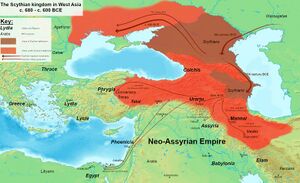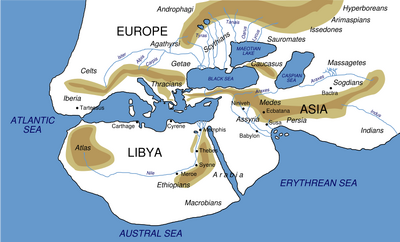Thrakia
| Author:Laxman Burdak, IFS (Retd.) |


Thracia or Thracia was the name of a province of the Roman Empire. It was established in AD 46, when the former Roman client state of Thrace was annexed by order of emperor Claudius (ruled 41-54).
Variants
- Thrace and Thracians (Anabasis by Arrian,p. 9-12, 15, 44, 53, 54, 69, 71, 75, 87, 93, 98, 108, 112, 148, 164, 298, 310, 340, 383, 391, 406.)
- Thracia (Pliny.vi.39)
- Thrace (Pliny.vi.39)
Location
Meaning
Thracians means[1] mountaineers; Hellenes, warriors; Dorians, high-landers; Ionians, coast-men; and Aeolians, mixed men. [2]
History
The Odrysian kingdom of Thrace became a Roman client kingdom ca. 20 BC, while the Greek city-states on the Black Sea coast came under Roman control, first as civitates foederatae ("allied" cities with internal autonomy). After the death of the Thracian king Rhoemetalces III in 46 AD and an unsuccessful anti-Roman revolt, the kingdom was annexed as the Roman province of Thracia.[3]

The new province encompassed not only the lands of the former Odrysian realm, but also the north-eastern portion of the province of Macedonia as well as the islands of Thasos, Samothrace and Imbros in the Aegean Sea. To the north, Thracia bordered the province of Moesia Inferior; initially, the provincial boundary ran at a line north of the Haeumus Mountains, including the cities of Nicopolis ad Istrum and Marcianopolis in Thracia, but by the end of the 2nd century AD the border had moved south along the Haemus. The area of the Thracian Chersonese (modern Gallipoli Peninsula) was excluded from its governor's purview and administered as part of the emperor's personal domains.[4] The province's first capital, where the Roman governor resided, was Heraclea Perinthus. Thracia was an imperial province, headed initially by a procurator, and, after ca. 107/109, by a legatus Augusti pro praetore. Otherwise, the internal structure of the old Thracian kingdom was retained and only gradually superseded by Roman institutions. The old tribal-based strategiai ("generalcies"), headed by a strategos ("general"), were retained as the main administrative divisions, but some villages were grouped together into kōmarchiai ("village headships") or subordinated to neighbouring cities (the two Roman colonies of colonia Claudia Aprensis and colonia Flavia Pacis Deueltensium and several Greek cities, many of whom were founded by Trajan), which were set apart. In the mid-1st century, the strategiai numbered fifty, but the progressive expansion of the cities and the land assigned to them reduced their number: by the early 2nd century, they had decreased to fourteen, and ca. 136 they were abolished altogether as official administrative divisions.[5]
As it was an interior province, far from the borders of the Empire, Thrace remained peaceful and prosperous until the Crisis of the Third Century, when it was repeatedly raided by Goths from beyond the Danube. During the campaigns to confront these raiders, Emperor Decius (r. 249–251) fell in the Battle of Abritus in 251. Thracia suffered especially heavily in the great Gothic seaborne raids of 268–270, and it was not until 271 that Emperor Aurelian (r. 270–275) was able to secure the Balkan provinces against Gothic raids for some time to come.[6]
Jat History
Hewitt[7] notes the connection between Jats and Goths: "The Jats ... trace their descent to the land of Ghazni and Kandahar, watered by the mother-river of the Kushika race, the sacred Haetuman or Helmand. Their name connects them with the Getae of Thrace, and thence with the Gattons, said by Pytheas to live on the southern shores of the Baltic, the Gaettones placed by Ptolemy and Tacitus on the Vistula in the country of the Lithuanians, and the Goths of Gothland = Sweden. This Scandinavian descent is confirmed by their system of land-tenure, for the chief tenure of the Muttra district is that called Bhagadura, in which the members of the village brotherhood each hold as their family property a separate and defined area among the village lands, according to the customs of the Bratovos of the Balkan peninsula and the Hof-bauers of North-West [8] Germany .. The Getae of the Balkans are said by Herodotus to be the bravest and most just of the Thracians."
James Francis Katherinus Hewitt[9] notes the connection between Jats and Goths: "The Jats ... trace their descent to the land of Ghazni and Kandahar, watered by the mother-river of the Kushika race, the sacred Haetuman or Helmand. Their name connects them with the Getae of Thrace, and thence with the Gattons, said by Pytheas to live on the southern shores of the Baltic, the Gaettones placed by Ptolemy and Tacitus on the Vistula in the country of the Lithuanians, and the Goths of Gothland = Sweden. This Scandinavian descent is confirmed by their system of land-tenure, for the chief tenure of the Muttra district is that called Bhagadura, in which the members of the village brotherhood each hold as their family property a separate and defined area among the village lands, according to the customs of the Bratovos of the Balkan Peninsula and the Hof-bauers of North-West [10] Germany .. The Getae of the Balkans are said by Herodotus to be the bravest and most just of the Thracians."
Prof. B.S. Dhillon[11]Jats writes....Jats are the one component of a group of people known as the Scythians in the Western countries and Sakas in India. Diodorus (first century B.C.) [12] wrote, "But now, in turn, we shall discuss the Scythians who inhabit the country bordering India. But some time later the descendants (Scythians) of these kings, because of their unusual valour and skill as generals, subdued much of the territory beyond the Tanais river (far eastern Europe) as far as Thrace (modern north of Greece), and advancing with their power as far as the Nile in Egypt. This people increased to great strength and had notable kings, one of whom gave his name to the Sacae (Sakas), another to the Massagetae ("great" Jats), another to the Arimaspi, and several other tribes". The recent edition of the Encyclopaedia Britannica [13] states "The Scythians were a people who during the 8th-7th centuries B.C. moved from Central Asia to Southern Russia, where they founded an empire that survived until they were gradually overcome and supplanted by the Sarmatians (another Scythian people) during the 4th century B.C. 2nd century A.D.".
Prof. B.S. Dhillon[14] quotes Hewitt, J.F. [15] who wrote, "The Getae of the Balkans are said by Herodotus (a fifth century BC writer) to be the bravest and most just of the Thracians. These Thracian Getae must, as a Northern race of individual proprietors, have held their lands on the tenure existing in the Jat villages, and these Indian Jats, or Getae, have not degenerated from the military prowess of their forefathers, for those Jats, who have become Sikhs in the Punjab, are known as some of the best and most reliable Indian soldiers".
External links
References
- ↑ Arrian:The Anabasis of Alexander/7a, Ch.9, f.n.1
- ↑ See Donaldson (New Cratylus, sect. 92).
- ↑ Soustal (1991), pp. 59–60
- ↑ Soustal (1991), p. 60
- ↑ Soustal (1991), pp. 60–61
- ↑ Soustal (1991), p. 62
- ↑ Hewitt 1894, p.481-482
- ↑ Hewitt 1894, p. 482
- ↑ Hewitt, James Francis (1894). The Ruling Races of Prehistoric Times in India, South-Western Asia and Southern Europe. London: Archibald Constable & Co. p. 481-482.
- ↑ Hewitt 1894, p. 482
- ↑ History and study of the Jats/Chapter 2, p.31
- ↑ Diodorus of Sicily (published around 49 B.C.), translated by C.H. Oldfather, Harvard University Press, Cambridge, Massachusetts, 1936, pp. 27-28 (Vol. II), pp. 377, 382-383 (Vol. VIII).
- ↑ Scythians, The Encyclopaedia Britannica, The New Encyclopaedia Britannica, Inc., Chicago, 1984, pp. 438-442.
- ↑ History and study of the Jats/Chapter 1,p.10
- ↑ Hewitt, J.F., The Ruling Races of Prehistoric Times in India, South-Western Asia and Southern Europe, Archibald Constable & Co., London, 1894, pp. 481-487.

